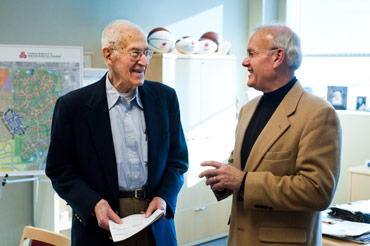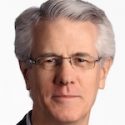Decades on, UW-Madison Research Park thrives, plans for growth
In the beginning, there was doubt.
Scroll back to the early 1980s, a time when the economy, like today, was in free fall. Unemployment soared, the energy crisis of the late 1970s lingered, and the industries America had always depended on underwent permanent transformation.
In that wobbly fiscal climate in small town Madison, Wis., an idea that had been kicked around since the early 1960s was beginning to take full form. The concept: a university research park, a place where basic science could be transformed into products and services, creating jobs and helping to lay the foundation of a new knowledge-based economy. It wasn’t an idea novel to Madison, certainly, as successful parks in North Carolina’s Research Triangle and California’s Silicon Valley had already been established. But the notion that such success could be replicated in Madison, even with a basic research powerhouse in the University of Wisconsin–Madison, was an idea that seemed to invite shots from all directions.

Irving Shain (left) and Mark Bugher, director of the University Research Park, talk in Bugher’s office. Shain is a former chancellor of UW–Madison and a longtime member of the research park’s board of trustees.
Photo: Jeff Miller
“There were a lot of doubters,” recalls Irving Shain, former UW–Madison chancellor and a driving force behind the establishment of the park on a pair of adjoining research farms encompassing 255 acres on Madison’s west side, an area of the city then undergoing rapid urbanization.
In the early years, beginning with the park’s formal establishment in 1984, development occurred, at best, in fits and starts, providing fodder for criticism such as this 1987 broadside from Capital Times business reporter Warren Gaskill: “There is probably no place in town that better summarizes the sluggish pace of high-tech development in Madison than the University of Wisconsin Research Park on the city’s west side.” Gaskill was not alone. Even newly elected governor and avid business booster Tommy Thompson expressed his frustration publicly: “Why aren’t we moving faster? Why haven’t we had more action out there?” Thompson wailed to the Milwaukee Sentinel’s Lee Bergquist.
“The development period was fraught with pessimism. We had a lot of false starts. A lot of people were unhappy with the progress,” Shain remembers. “People had visions of an IBM or a big pharmaceutical company moving in. But these big companies weren’t interested in putting money into a park that didn’t have anything in it.”
At the time, the park had a single tenant: Warzyn Engineering, a company specializing in groundwater remediation. The park had also adopted a philosophy of limiting development in the park to firms that had a real connection to research. Ideas for hotels and commercial development such as restaurants and video rental stores were floated, but the park and its leadership, notably its first director and visionary, Wayne McGown, stuck to its policy in spite of criticism that it was bogging down the park’s development.
Although the measured pace of development was frustrating for many, the park was not without its boosters, notably the Wisconsin State Journal and its editor, Robert Spiegel, the Madison Chamber of Commerce and, critically, the Wisconsin Alumni Research Foundation (WARF). “The city, the university, the business community and the city’s largest newspaper all played a role in pulling people and ideas together,” notes Tom Still, a former editorial writer for the Wisconsin State Journal and now the president of the Wisconsin Technology Council, itself a tenant of the park.
Absent big-name entities, what the park’s managers were learning, says Shain, who still serves on the park’s board of trustees, was that there was demand for small spaces, the kind of setting that would fit a startup, a company founded, perhaps, by a professor with a good idea and a small bankroll.
“We did find a lot of small companies that wanted 2,500 square feet of space, not 10,000 square feet,” says Shain. “Our big break came when Madison Gas and Electric (MGE) agreed to rent a small building if we would build it and couldn’t rent it to anyone else. The four-suite, 10,000-square-foot building, the original MGE Innovation Center, was rented before it was completed and MGE said ‘Why don’t you build another?'”
Nine buildings later, University Research Park was finally on a track to becoming the kind of research park that today is an envied engine of high-tech economic development. “Now, research parks are fashionable,” notes the park’s current director, Mark Bugher. “Then, they were almost unknown. Ours has been transformational for our technology transfer program.”

A 2009 artist’s rendering shows an aerial map of development plans for the University Research Park 2 (URP2), sited on Madison’s far west side. The location is bordered by (clockwise from top of map) Mineral Point Road, County M and Pleasant View Road. Groundbreaking for URP2 is planned for this spring. Download as PDF (3.6 MB)
Indeed. Today, the park is the setting for more than 100 companies in 32 buildings employing between 3,500 and 4,000 people with an estimated annual payroll of almost $250 million. In 2009, the park paid nearly $3.6 million in property taxes, and each year the park returns on the order of $500,000 to the university. A 2006 study by NorthStar Economics reported that the park directly and indirectly contributes an estimated $680 million to the state’s economy.
Many of the companies in the park — Third Wave, Roche NimbleGen, Stemina, Cell Line Genetics Stratatech, Quintessence Biosciences — emerged directly from UW–Madison research; others — Mentor, Ultratec, Stemina — settled in the park to capitalize on its proximity to the intellectual resources of UW–Madison. Up to 70 percent of the companies in the park, says Bugher, have direct or indirect links to UW–Madison.
A key to the park’s success, according to WARF managing director Carl Gulbrandsen, is incubator space for fledgling technology companies: “That space is really important for the startups,” says Gulbrandsen, noting that situating entrepreneurs in close proximity to one another has cross-pollinating and inspirational influences. “Looking at our list of startups, we have a lot more that are successful than you would ordinarily have in a university setting.”
The philosophy and goal of using the park as a means to take ideas from the university laboratory to market have been advanced through close collaboration and mutual support between WARF and University Research Park, note both Bugher and Gulbrandsen.
WARF’s ability to leverage technology in the interest of local economic development, says Shain, was due in part to changes in policy that let WARF begin to license inventions back to faculty inventors in exchange for equity in the new startups. “That made it possible for technology development to really blossom here,” Shain argues.
Growing a technology economy through entities such as University Research Park, says Bugher, is also a way to keep talent in Madison and Wisconsin: “This is our ‘brain gain’ strategy. If it weren’t for the park, these folks would be somewhere else. We know people will stay here if they can find a job.”
Nearing the current park’s capacity, Bugher and his team are preparing to break ground this year for University Research Park 2 on a 270-acre site about 2 miles west of the original park. The park has also established the Metro Innovation Center, a 10-suite urban park in the historic Gisholt Machine Company building on Madison’s near east side. Established in 2009, the Metro Innovation Center is designed to foster “computational and computer-intensive” startups by providing state-of-the-art voice and data services through a secure, 1-gigabyte data connection to UW–Madison. The center already has four tenants, three of which were started by recent UW–Madison graduates, according to Greg Hyer, associate director of University Research Park.
As a grand experiment in technology transfer, the vision and approach of the park’s founders, says Still, has been validated. The park has shown, he says, that ideas born in basic research can be spun into companies, jobs, local tax revenue and an enhanced local quality of life.
The enduring lessons? “Public-private partnerships can work. Patience is golden. Economic cycles don’t follow election cycles. Invest in the next generation of ideas,” argues Still.
Note: Images to accompany this story can be downloaded at http://www.news.wisc.edu/newsphotos/URP2010.html



